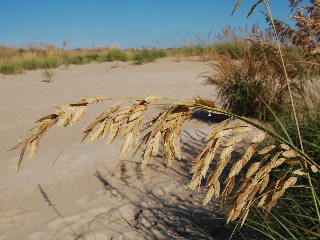
Hello students, let’s start today’s class with a brief pop quiz!
Here are your questions.
Number one--if this class is called “Green News”, then why are we talking about sea oats?
And, number two--if we’re having this discussion and posting this article in January (the dead of winter), why are we talking about sea oats, which are usually associated with the beauty and good times of the summer beach?!
Okay, since you give up, here’s the answer. Seas oats play a major part in maintaining and protecting our precious natural environment, and we need to be aware of protecting the environment every day and every season of the year no matter where we are!
Now, stop your groaning, please, at my roundabout way of getting your attention for our discussion of sea oats. Let’s proceed.
Sea oats is a perennial grass found naturally growing along United States coastal areas from Virginia southward to Florida and along the Gulf Coast on down to coastal Mexico.
The plant is extremely drought resistant and requires almost no nutrients to sustain itself once it is established.
The roots are deep and extensive, giving the sea oat plants a strong grip to anchor themselves firmly in place against the often gusty winds of the coastal areas.
It’s this strong root system that enables the sea oat plants to be such an important factor in protecting and stabilizing the shifting sands of their delicate coastal landscapes.
Sea oats propagate themselves by means of both seeds and rhizomes.
This means that those attractive sand-colored seed heads that we see on mature plants at the beach do indeed cast those seeds to the wind in search of suitable sites for germinating and establishing new plants in the surrounding areas.
And, that strong and extensive root system that we mentioned does indeed produce underground shoots that launch new upright stems to help spread and broaden the plant.
Laws regarding the protection of sea oats vary from state to state, so be sure you are not breaking the law if you decide to pluck some of these attractive plants from their coastal homes.
Hopefully, we all want to be good stewards of the natural environment. So it’s best to just enjoy these beauties where they are, take photographs of them, and be happy and proud that we are fortunate enough to be part of the picture ourselves.
 Hello students, let’s start today’s class with a brief pop quiz!
Hello students, let’s start today’s class with a brief pop quiz!